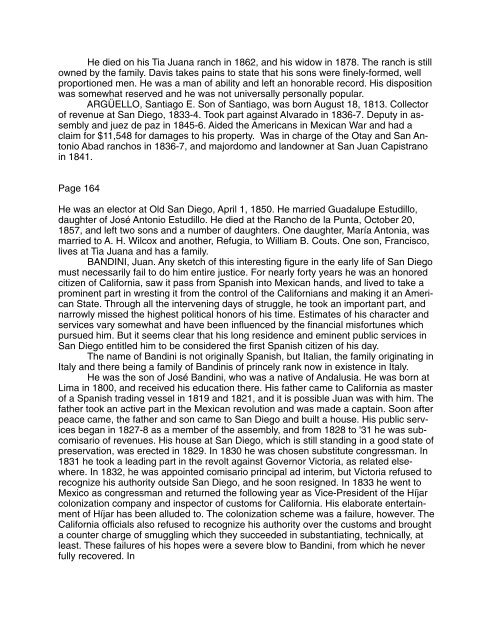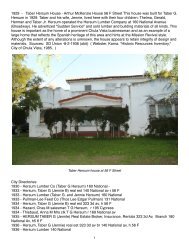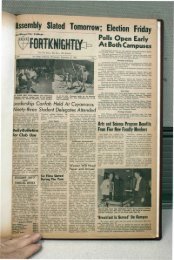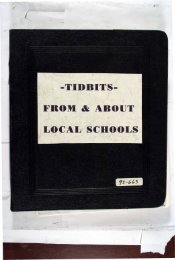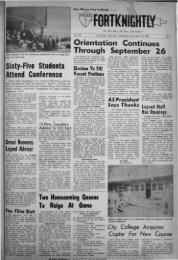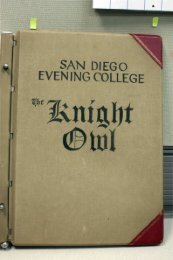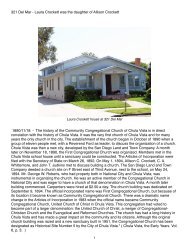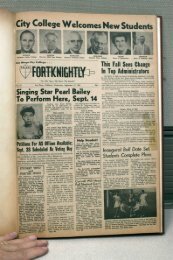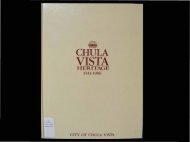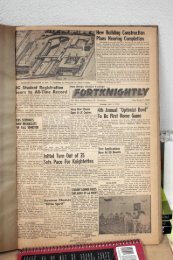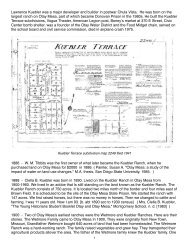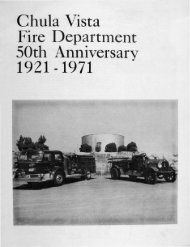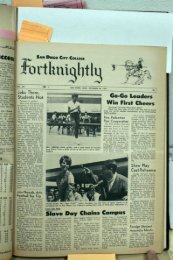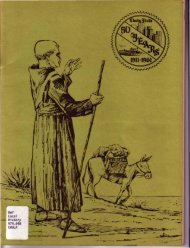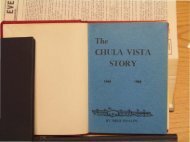doc241 - Schoenherr Home Page in Sunny Chula Vista
doc241 - Schoenherr Home Page in Sunny Chula Vista
doc241 - Schoenherr Home Page in Sunny Chula Vista
You also want an ePaper? Increase the reach of your titles
YUMPU automatically turns print PDFs into web optimized ePapers that Google loves.
He died on his Tia Juana ranch <strong>in</strong> 1862, and his widow <strong>in</strong> 1878. The ranch is still<br />
owned by the family. Davis takes pa<strong>in</strong>s to state that his sons were f<strong>in</strong>ely-formed, well<br />
proportioned men. He was a man of ability and left an honorable record. His disposition<br />
was somewhat reserved and he was not universally personally popular.<br />
ARGÜELLO, Santiago E. Son of Santiago, was born August 18, 1813. Collector<br />
of revenue at San Diego, 1833-4. Took part aga<strong>in</strong>st Alvarado <strong>in</strong> 1836-7. Deputy <strong>in</strong> assembly<br />
and juez de paz <strong>in</strong> 1845-6. Aided the Americans <strong>in</strong> Mexican War and had a<br />
claim for $11,548 for damages to his property. Was <strong>in</strong> charge of the Otay and San Antonio<br />
Abad ranchos <strong>in</strong> 1836-7, and majordomo and landowner at San Juan Capistrano<br />
<strong>in</strong> 1841.<br />
<strong>Page</strong> 164<br />
He was an elector at Old San Diego, April 1, 1850. He married Guadalupe Estudillo,<br />
daughter of José Antonio Estudillo. He died at the Rancho de la Punta, October 20,<br />
1857, and left two sons and a number of daughters. One daughter, María Antonia, was<br />
married to A. H. Wilcox and another, Refugia, to William B. Couts. One son, Francisco,<br />
lives at Tia Juana and has a family.<br />
BANDINI, Juan. Any sketch of this <strong>in</strong>terest<strong>in</strong>g figure <strong>in</strong> the early life of San Diego<br />
must necessarily fail to do him entire justice. For nearly forty years he was an honored<br />
citizen of California, saw it pass from Spanish <strong>in</strong>to Mexican hands, and lived to take a<br />
prom<strong>in</strong>ent part <strong>in</strong> wrest<strong>in</strong>g it from the control of the Californians and mak<strong>in</strong>g it an American<br />
State. Through all the <strong>in</strong>terven<strong>in</strong>g days of struggle, he took an important part, and<br />
narrowly missed the highest political honors of his time. Estimates of his character and<br />
services vary somewhat and have been <strong>in</strong>fluenced by the f<strong>in</strong>ancial misfortunes which<br />
pursued him. But it seems clear that his long residence and em<strong>in</strong>ent public services <strong>in</strong><br />
San Diego entitled him to be considered the first Spanish citizen of his day.<br />
The name of Band<strong>in</strong>i is not orig<strong>in</strong>ally Spanish, but Italian, the family orig<strong>in</strong>at<strong>in</strong>g <strong>in</strong><br />
Italy and there be<strong>in</strong>g a family of Band<strong>in</strong>is of pr<strong>in</strong>cely rank now <strong>in</strong> existence <strong>in</strong> Italy.<br />
He was the son of José Band<strong>in</strong>i, who was a native of Andalusia. He was born at<br />
Lima <strong>in</strong> 1800, and received his education there. His father came to California as master<br />
of a Spanish trad<strong>in</strong>g vessel <strong>in</strong> 1819 and 1821, and it is possible Juan was with him. The<br />
father took an active part <strong>in</strong> the Mexican revolution and was made a capta<strong>in</strong>. Soon after<br />
peace came, the father and son came to San Diego and built a house. His public services<br />
began <strong>in</strong> 1827-8 as a member of the assembly, and from 1828 to '31 he was subcomisario<br />
of revenues. His house at San Diego, which is still stand<strong>in</strong>g <strong>in</strong> a good state of<br />
preservation, was erected <strong>in</strong> 1829. In 1830 he was chosen substitute congressman. In<br />
1831 he took a lead<strong>in</strong>g part <strong>in</strong> the revolt aga<strong>in</strong>st Governor Victoria, as related elsewhere.<br />
In 1832, he was appo<strong>in</strong>ted comisario pr<strong>in</strong>cipal ad <strong>in</strong>terim, but Victoria refused to<br />
recognize his authority outside San Diego, and he soon resigned. In 1833 he went to<br />
Mexico as congressman and returned the follow<strong>in</strong>g year as Vice-President of the Híjar<br />
colonization company and <strong>in</strong>spector of customs for California. His elaborate enterta<strong>in</strong>ment<br />
of Híjar has been alluded to. The colonization scheme was a failure, however. The<br />
California officials also refused to recognize his authority over the customs and brought<br />
a counter charge of smuggl<strong>in</strong>g which they succeeded <strong>in</strong> substantiat<strong>in</strong>g, technically, at<br />
least. These failures of his hopes were a severe blow to Band<strong>in</strong>i, from which he never<br />
fully recovered. In


